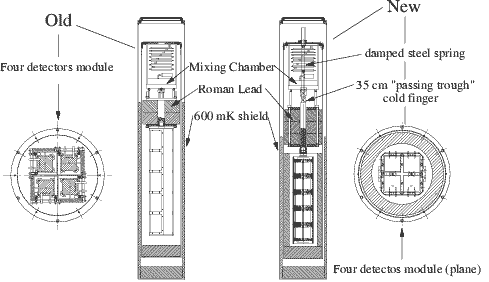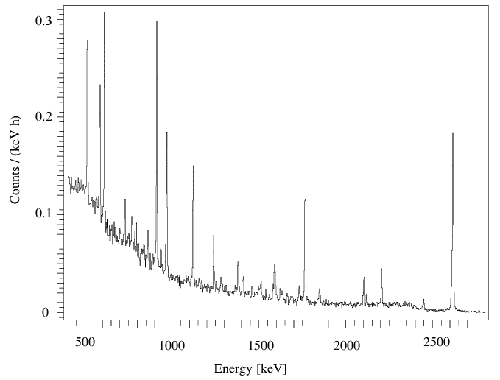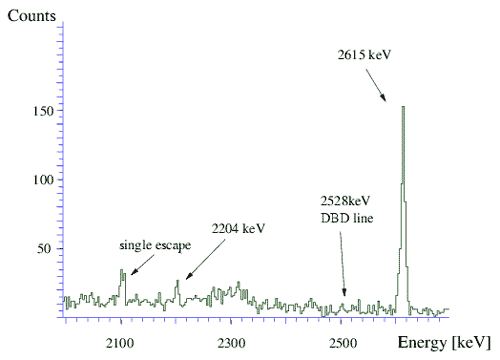 The
Mi-DBD array (tower) consists in a stack of five floors, each consisting of 4
detectors. Each detector consists of a massive absorber and a proper temperature
sensor in thermal contact with it. The array operates inside a dilution refrigerator
in the Gran Sasso Underground Laboratory. The twenty absorbers are crystals of
TeO2 of 3x3x6 cm3 volume with a total active mass of about
6.8 kg, the largest in any cryogenic experiment. Sixteen of these crystals are
made of natural telluride. Two contain tellurium isotopically enriched at 82.3
% in 128Te and other two at 75.0 % in 130Te.
The
Mi-DBD array (tower) consists in a stack of five floors, each consisting of 4
detectors. Each detector consists of a massive absorber and a proper temperature
sensor in thermal contact with it. The array operates inside a dilution refrigerator
in the Gran Sasso Underground Laboratory. The twenty absorbers are crystals of
TeO2 of 3x3x6 cm3 volume with a total active mass of about
6.8 kg, the largest in any cryogenic experiment. Sixteen of these crystals are
made of natural telluride. Two contain tellurium isotopically enriched at 82.3
% in 128Te and other two at 75.0 % in 130Te.
 |
Simplified scheme of the two detector setups of the MiDBD experiment. |
The temperature sensors are Neutron Transmutation
Doped (NTD) Ge thermistors. They were specifically prepared in order to present
similar thermal performance. A resistor of 100-200 kW,
realized with a heavily doped meander implanted on a 1 mm3 silicon
chip, is attached to each absorber and acts as a heater to calibrate and stabilize
the gain of the bolometer over long running periods. The tower is connected
via an OFHC copper cold finger to the mixing chamber (coldest point) of a dilution
refrigerator specially constructed with previously tested low radioactivity
materials. The entire setup is shielded with two layers of lead of 10 cm minimum
thickness each. The outer one is made of common low radioactivity lead, the
inner of special lead with a contamination of 16 ± 4
Bq/kg in 210Pb. The refrigerator is surrounded by a Plexiglas anti-radon
box fluxed with clean N2 from a liquid nitrogen evaporator, and
by a Faraday cage to eliminate electromagnetic interference.
 |
Scheme of the experimental setup of the MiDBD experiment @ LNGS (Hall A) |
Experiment runs were carried out in two separate runs. A series of improvements were implemented for the latter one: 1) surface treatment of all crystal and mounting structure copper surfaces in order to reduce the radioactive contaminations introduced in the preparation processes; 2) more compact assembling of the crystals; 3) elastic suspension of the tower by means of a steel spring, in order to reduce vibrations.
The front-end electronics of each detector is located at room temperature and consists of a differential voltage sensitive preamplifier followed by a second stage and an antialiasing filter. A pair of room temperature load resistors (30 GW metal films) serves to bias each bolometer in a symmetric way. In both runs the array was cooled down to temperatures around 8 mK with a temperature spread of ~1 mK The detectors were calibrated by means of regular exposures to a combined radioactive source of 238U and 232Th placed just outside the dilution refrigerator. The detectors FWHM energy resolutions at the 2615 keV line of 208Tl range from 5 to 15 keV.
 |
Sum calibration spectrum obtained exposing the array detectors to a combined radioactive source of 238U and 232Th placed just outside the dilution refrigerator. |
The two set-up have been operated for effective running times of ~31,508 and 5,690 hours x kg, respectively. In all background spectra the main lines due to the natural activity of the 232Th and 238U chains, of 40K and the lines at 1173 and at 1332 keV due to cosmogenic 60Co are present. In addition there are lines at 89 and 248 keV and an excess activity in the line at 144 keV which can be attributed to 123mTe, 125mTe and 127mTe produced by activation of tellurium from cosmic rays. No peak appears in the region of neutrinoless DBD of 130Te, where the rates are of 0.59 ± 0.06 and 0.33 ± 0.11 counts keV-1 kg-1 year-1 for the former and latter run, respectively. No peak appear at the energies corresponding to neutrinoless DBD of 130Te to excited levels of 130Xe, and at the energy of 867 keV corresponding to neutrinoless DBD of 128Te.
The region above 2000 keV of the total collected spectrum, corresponding to ~3.56 kg x year of TeO2 and to ~0.98 kg x year of 130Te is shown in Figure. The clear peaks corresponding to the lines at 2104 keV (single escape of the 2615 keV 208Tl line ), at 2204 keV (214Bi) and at 2615 keV ( 208Tl ), confirms the reproducibility of the array during both runs.
 |
High energy region of the background spctrum of the MiDBD experiment |
The 90 % c.l. limits for the various decay processes are reported in the Table. For what concerns 0nDBD they correspond to lower limits on <mn> which are the most stringent after those obtained with Germanium diodes.
-
Isotope
Transition
T1/2 (y)
130Te
0nDBD(0+)
< 2.1 x 1023
130Te
0nDBD(2+)
< 1.4 x 1023
130Te
2nDBD(0+)
< 3.8 x 1020
130Te
1cDBD(0+)
< 2.2 x 1021
130Te
2cDBD(0+)
< 0.9 x 1021
128Te
0nDBD(0+)
<1.1 x 1023